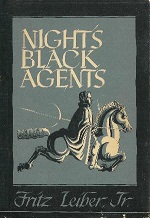|  | | | | 

| | “The Man Who Never Grew Young”
by Fritz Leiber, Jr.
First publication: Night’s Black Agents, 1947

 Without knowing why, our narrator describes his life as a man who stays the same for millennia, even as others, one-by-one, are disintered, slowly grow younger and younger. Without knowing why, our narrator describes his life as a man who stays the same for millennia, even as others, one-by-one, are disintered, slowly grow younger and younger.

The story is soft-spoken but moving, and for me, it was a good complement to T.H. White’s backward-time-traveler, Merlyn. It is the same in all we do. Our houses grow new and we dismantle them and stow the materials inconspicuously away, in mine and quarry, forest and field. Our clothes grow new and we put them off. And we grow new and forget and blindly seek a mother. It is the same in all we do. Our houses grow new and we dismantle them and stow the materials inconspicuously away, in mine and quarry, forest and field. Our clothes grow new and we put them off. And we grow new and forget and blindly seek a mother. 
| |
| | | | |

 
 
 
 
 
 
 
 
 
 
 
 
 
No Time Travel. Move along. |
“No-Sided Professor” by Martin Gardner, Esquire, Jan 1947 [4D spacial topology ]

| |     |